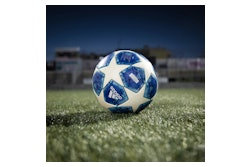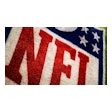Facility managers must remain grounded when keeping their sports surfaces safe, or else they may find themselves in a legal quagmire.
 Photo of a poorly maintained soccer field
Photo of a poorly maintained soccer fieldCherlynn Tang and her teenage children spent much of their Valentine's Day noon hour skating on a temporary ice rink in Irvine, Calif. As skaters were instructed to vacate the ice, which after 45 minutes was due for a resurfacing, Tang allegedly glided over a puddle of melt water, lost her footing and fell backwards. Her resulting head injury proved fatal just days later.
Attorneys representing the Tang family in March cited the condition of the rink - situated outdoors in a park and open for business despite temperatures topping 80 degrees - as well as a lack of on-site medical attention in four wrongful-death claims that seek $40 million total. "It's foreseeable that someone is going to fall when they're ice-skating, especially when you invite families and complete novices for free to an open-air, rinky-dink neighborhood ice rink," says Ed Susolik, an attorney at prominent personal-injury firm Callahan & Blaine who's representing Tang's widower and their three children, adding that the quality of the ice itself "absolutely played a role" in the tragedy.
Maintaining ice in balmy California may not be your business, but if you manage virtually any type of sports or recreation facility, the above case should get your attention nonetheless. Until a physical activity is invented in which participants actually levitate (Quidditch, anyone?), one universal law applies to all the rest: gravity. Therefore, facility managers must remain grounded when keeping their surfaces safe for use, or else they may find themselves in a legal quagmire.
"A lot of sports law cases deal with actual injuries, and one of the things that seemingly everybody argues is that there was a problem with the surface," says attorney and law professor John Wolohan, chair of the Sport Management & Media Department at Ithaca College and author of AB's monthly Sports Law column. "In most of the cases that I've come across, there is some validity to it."
Earlier this year, a judge ruled that the case of Mark Sanford, who was playing soccer in 2005 when he stepped in a hole on a field at Greenwich (Conn.) Middle School and broke his ankle, would go to trial next February. The Sanford family, citing Mark's handicap (despite surgery, his foot remains crooked) in terms of playing competitive sports beyond high school, claims the school had left its field poorly inspected and unsafe, and seeks more than $15,000. Then there's the case of Blake Garcia, who contends that an ankle injury he suffered in September 2008 was caused by the "deplorable" conditions of a Lake Havasu (Ariz.) Unified School District football practice field, and later exacerbated by a slip and fall on wet flooring in the training room, which was subsequently retrofitted with a drain. As for the field, calls for a re-sod had been made in March 2007 in a freshman-penned letter to the editor of Lake Havasu's student newspaper. Garcia's claim, filed last December, seeks $350,000.
The damages sought may differ greatly, but the questions facing defendants is often the same: Was the alleged surface defect foreseeable and was it fixable? Says risk management expert Todd Seidler, coordinator of the Sport Administration graduate program at the University of New Mexico, "We have a park here in Albuquerque that has lots of gophers, and it can change from one day to the next. It can be fine one day and the next day have several holes in it, so we recommend that you inspect daily before you send people out on a field, and if there are holes, fill them in."
According to Mike Andresen, manager of facilities and grounds for the Iowa State University athletic department and a past president of the Sports Turf Managers Association, a game-day field inspection should not only target divots and holes in the surface, but sharp objects that may be hidden there, as well. Same goes for synthetic turf, which can collect bobby pins, track shoe spikes, sheet-metal screws and other injury-causing detritus. And while synthetic turf isn't prone to animal infestation, it can exhibit signs of neglect just like natural grass. Seidler, who travels the country inspecting facilities as proprietor of Southwest Sports Management LLC, was called to nearby Rio Rancho, N.M., recently to survey a synthetic surface. He found worn patches, exposed seams and further evidence that favored replacement - not the least of which was a single-season record number of concussions suffered by the Rio Rancho High School football team. (The National Athletic Trainers' Association's seven-point "call to action" regarding concussions urges athletic directors, coaches, teachers, parents' athletic trainers and athletes themselves to "ensure that sports equipment and playing surfaces are checked for safety and best conditions prior to activity.") In addition, the football team at one point saw 11 players sidelined due to ankle and knee injuries attributed to the hardness of the field. "I believe that the RRHS football field presents an elevated risk of injury to players and that such injuries may increase the district's exposure to possible legal action," Seidler reported. Earlier this year, $826,000 in bond money earmarked for new restrooms and a third concessions stand at the Rio Rancho stadium was diverted toward the purchase of a new surface.
Beware, though, that problems can begin at installation. Two years ago, the Gettysburg (S.D.) School District successfully sued a paving company that had failed to properly compact the soil sub-base and gravel layer under a new asphalt track, which soon exhibited cracks, crooked lane lines and surface depressions where standing water would collect. One attempt at repair arguably made the problems worse, before a third-party expert deemed a second repair attempt futile. The district was ultimately awarded $278,450, but it had lost nearly three years of what should have from the start been worry-free track use.
Assuming a surface has been properly installed, its upkeep should be carried out with due diligence and be well documented. A baseball or softball infield, where the vast majority of action takes place, should be rid of stones and other debris, watered regularly and dragged carefully so that material doesn't form a dangerous lip where the skinned area meets grass. The American Softball Association's 2010 field owners insurance plan enrollment form states in bold print that field owners are the main targets of softball lawsuits and that the main basis of those suits is field conditions. It makes coverage contingent upon field owners inspecting all insured fields and surrounding premises and filling out ASA-provided inspection forms.
A fresh coat of paint applied every six years to an asphalt tennis court will keep oil from evaporating from the surface and stretch its lifespan. Cracks in asphalt courts are inevitable, though, and if left untreated with acrylic fillers, asphalt patches or geotextile overlays, will only get larger - particularly in a freeze-thaw environment. A hairline crack will expand to a half-inch within three years, according to one court construction expert, and by then you're talking about a tripping hazard.
One surface that requires near constant attention and on-site expertise is ice. A hastily made ice sheet can prove "chippy" at the surface, or worse, larger chunks can break free from the sheet's bond to the arena floor. Arguably, no surface undergoes as much punishment, or requires a resurfacing multiple times daily under normal use.
There may be nothing wrong with the given sports surface itself, but that doesn't guarantee safe play. Condensate dripping from an ice rink's rafters can create tripping hazards in the form of small nodes on the skating surface. Water introduced to a court surface can lead to slip-and-fall liability. An alleged building leak during a youth basketball game was the focus of a recent $25,000 lawsuit against the city of Mansfield, Ohio, where a mother says her son slipped and broke his jaw on a floor that she contends remained slippery despite being mopped.
Detrimental forces of nature - beyond burrowing animals - must be anticipated, too. A playground may be blanketed by impact-absorbing rubber or the recommended 12 inches of engineered wood-fiber chips, but all safety bets are off once that material is subjected to freezing temperatures. A loose-laid wood surface might freeze overnight, rendering play equipment unusable, then take much longer to sufficiently thaw and soften due to its own insulating qualities.
It's possible that a surface is inherently unsuitable for physical activity. The vinyl composition tile found in many school classrooms and corridors is often specified as the gymnasium's surface, too - with catastrophic results. Meagan Wiedeman, a seventh-grader at Leyton Junior High School in Gurley, Neb., sustained a fatal skull fracture in 2003 after missing the pit during a high jump attempt and landing instead on a VCT floor, which some experts estimate to be eight times harder than flooring designed for active play. Mackenzie Clay, a former high school wrestler who suffered a paralyzing spinal-cord injury when two wrestlers fell on him and his practice partner, collected $15 million total from Seattle Public Schools and the Washington Schools Risk Management Pool after successfully arguing that the mat placed on a concrete cafeteria floor was too small for the number of wrestlers using it, and that additional mats were left unused. Hard surfaces surrounding pole vault pits and in the plant box have been the target of new recommendations regarding supplemental surface padding, spurred in large part by a spate of fatal accidents beginning in 2002.
Poor meet management is another component of facility operations that can land an athlete on the wrong surface and meet managers in legal trouble. Seidler points to one case in which the takeoff point for a long-jump competition was placed too close to the landing pit. It wasn't a problem for any competitor except the event's eventual winner, who cleared the pit entirely and hyperextended his knee on the hard grass surface beyond the sand.
It's also possible that an unsuitable surface is specified for non-activity spaces within a facility. Seidler recalls his surprise to find terrazzo installed as one facility's locker room flooring - and without any drainage slope or a drain. Several coats of textured paint failed to adhere to the surface, which ultimately was covered with flow-through tile. "I've seen several locker rooms and even showers that have terrazzo floors," Seidler says. "It's polished concrete with marble, and it's like ice when it gets wet. It's just a stupid design. Terrazzo is expensive in the first place, and then they had to spend more money to fix it."
If surface safety corners do get cut, threadbare budgets are to blame as often as poor design judgment or a lack of maintenance acumen, particularly at the youth and high school sports levels. But investing in safety early can spare a sports organization major financial headaches - if not outright ruin - down the road.
Selecting a reputable manufacturer and contractor to build and install your surface is the first step toward protecting against future legal challenges. Seek qualified professionals through industry trade associations and demand a list of references for both successfully completed projects and those that encountered difficulty along the way. Make sure that a completion date is specified in writing, and that a third-party inspection ensures the final product conforms to industry construction standards and performance criteria for the desired level of play as laid out by appropriate sports governing bodies. Hire qualified maintenance personnel and train them in proper surface care (to manufacturer's specifications, if applicable). And, again, inspect all surfaces prior to activity, identify all potential injury risks, eliminate those hazards and keep detailed records of the process.
According to Safe Kids USA, part of a global network of organizations seeking to prevent accidental childhood injuries, the three most common sites of school injuries are playgrounds, athletic fields and gymnasiums. The surfaces underfoot in these facilities make inviting targets in the event of an accident (the U.S. Consumer Product Safety Commission estimates that 70 to 80 percent of all playground accidents are falls). Sports organizations and facility managers who devote the time and resources necessary to ensure safe play on their surfaces all but guarantee their own solid legal footing.
"Dangerous surfaces are one of the leading causes of injuries related to sport and recreation facilities," Seidler says. "Whether slippery, uneven or improper for a given activity, unsafe surfaces can pose foreseeable dangers to participants, spectators, visitors and staff alike. Selecting the proper surface and establishing a program for proper maintenance is good risk management."

































